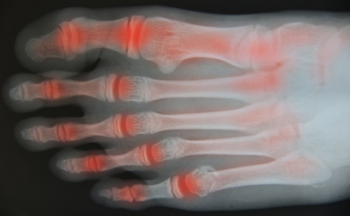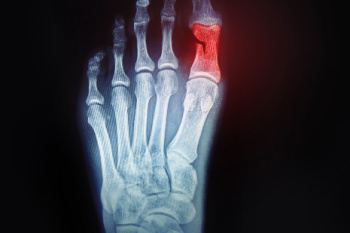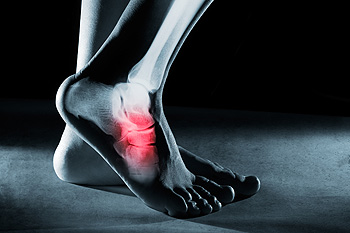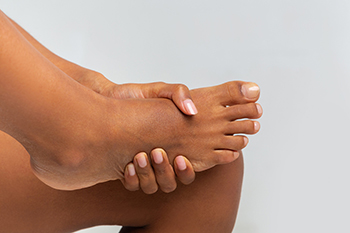Connect With Us
Blog
Items filtered by date: July 2024
Stretches and Exercises to Relieve Foot Arthritis

Foot arthritis can be debilitating, but incorporating stretches and exercises into your daily routine can help alleviate pain and improve mobility. Toe curls are where you scrunch a towel with your toes to strengthen the muscles in your feet and promote flexibility. Ankle circles help maintain joint mobility and reduce stiffness. Calf stretches, such as leaning against a wall with one leg extended behind you, help stretch the muscles and tendons in your lower leg, easing strain on arthritic joints. Toe stretches, gently pulling each toe back for a few seconds, can increase flexibility and reduce discomfort. Finally, seated heel raises, lifting your heels off the ground while seated, strengthen the muscles in your calves and feet, providing support to arthritic joints. If you have arthritis in your feet, it is suggested that you are under the care of a podiatrist who can help you to manage this condition.
Arthritis can be a difficult condition to live with. If you are seeking treatment, contact Landon Bowerbank, DPM from Pioneer Foot and Ankle. our doctor can provide the care you need to keep you pain-free and on your feet.
Arthritic Foot Care
Arthritis is a term that is commonly used to describe joint pain. The condition itself can occur to anyone of any age, race, or gender, and there are over 100 types of it. Nevertheless, arthritis is more commonly found in women compared to men, and it is also more prevalent in those who are overweight. The causes of arthritis vary depending on which type of arthritis you have. Osteoarthritis for example, is often caused by injury, while rheumatoid arthritis is caused by a misdirected immune system.
Symptoms
- Swelling
- Pain
- Stiffness
- Decreased Range of Motion
Arthritic symptoms range in severity, and they may come and go. Some symptoms stay the same for several years but could potentially get worse with time. Severe cases of arthritis can prevent its sufferers from performing daily activities and make walking difficult.
Risk Factors
- Occupation – Occupations requiring repetitive knee movements have been linked to osteoarthritis
- Obesity – Excess weight can contribute to osteoarthritis development
- Infection – Microbial agents can infect the joints and trigger arthritis
- Joint Injuries – Damage to joints may lead to osteoarthritis
- Age – Risk increases with age
- Gender –Most types are more common in women
- Genetics – Arthritis can be hereditary
If you suspect your arthritis is affecting your feet, it is crucial that you see a podiatrist immediately. Your doctor will be able to address your specific case and help you decide which treatment method is best for you.
If you have any questions, please feel free to contact our office located in Lehi, UT . We offer the newest diagnostic and treatment technologies for all your foot care needs.
Are You Suffering From Nerve Damage?
Various Foot Fractures and Relief Strategies

Foot fractures encompass a spectrum of injuries, each demanding specific attention and care. Among them, the Jones fracture affects the fifth metatarsal bone, typically requiring immobilization through casting or surgery to ensure proper healing. Metatarsal shaft fractures, occurring along the long bones of the foot, often necessitate rest, elevation, and the use of crutches to alleviate pressure. Proximal fifth metatarsal tuberosity avulsion fractures involve the pulling away of a small bone fragment due to sudden muscle contractions, often managed with immobilization and gradual return to weight-bearing activities. Additionally, big toe fractures, whether simple or complex, may require splinting, taping, or buddy taping to adjacent toes to promote stability. Relief techniques for foot fractures commonly involve rest and elevation to mitigate swelling and pain. Immobilization aids like casts, braces, or boots help stabilize the injured area, facilitating proper healing. If you have broken your foot, it is strongly suggested that you consult a podiatrist who can determine what type of fracture you have, and offer appropriate treatment methods.
A broken foot requires immediate medical attention and treatment. If you need your feet checked, contact Landon Bowerbank, DPM from Pioneer Foot and Ankle. our doctor can provide the care you need to keep you pain-free and on your feet.
Broken Foot Causes, Symptoms, and Treatment
A broken foot is caused by one of the bones in the foot typically breaking when bended, crushed, or stretched beyond its natural capabilities. Usually the location of the fracture indicates how the break occurred, whether it was through an object, fall, or any other type of injury.
Common Symptoms of Broken Feet:
- Bruising
- Pain
- Redness
- Swelling
- Blue in color
- Numbness
- Cold
- Misshapen
- Cuts
- Deformities
Those that suspect they have a broken foot shoot seek urgent medical attention where a medical professional could diagnose the severity.
Treatment for broken bones varies depending on the cause, severity and location. Some will require the use of splints, casts or crutches while others could even involve surgery to repair the broken bones. Personal care includes the use of ice and keeping the foot stabilized and elevated.
If you have any questions please feel free to contact our office located in Lehi, UT . We offer the newest diagnostic and treatment technologies for all your foot and ankle needs.
What to Do if Your Child Breaks a Toe
 Broken toes in kids are common due to their active lifestyles and frequent participation in sports and play. These fractures often occur from stubbing the toe, dropping heavy objects on the foot, or direct impacts during activities. Symptoms of a broken toe include severe pain, swelling, bruising, and difficulty walking or bearing weight on the affected foot. The pain from a broken toe is usually immediate and intense, with visible deformity or misalignment in severe cases. If a child complains of persistent pain and shows signs of swelling or discoloration, a fracture is likely. Treatment for broken toes in children typically involves rest, compression, and elevation to reduce swelling and alleviate pain. Immobilizing the toe with a splint or buddy-taping it to an adjacent toe can help maintain alignment and promote healing. Pain relievers may be used to manage discomfort. If you suspect your child has broken a toe, it is suggested that you schedule an appointment with a podiatrist for a proper diagnosis and appropriate treatment.
Broken toes in kids are common due to their active lifestyles and frequent participation in sports and play. These fractures often occur from stubbing the toe, dropping heavy objects on the foot, or direct impacts during activities. Symptoms of a broken toe include severe pain, swelling, bruising, and difficulty walking or bearing weight on the affected foot. The pain from a broken toe is usually immediate and intense, with visible deformity or misalignment in severe cases. If a child complains of persistent pain and shows signs of swelling or discoloration, a fracture is likely. Treatment for broken toes in children typically involves rest, compression, and elevation to reduce swelling and alleviate pain. Immobilizing the toe with a splint or buddy-taping it to an adjacent toe can help maintain alignment and promote healing. Pain relievers may be used to manage discomfort. If you suspect your child has broken a toe, it is suggested that you schedule an appointment with a podiatrist for a proper diagnosis and appropriate treatment.
A broken toe can be very painful and lead to complications if not properly fixed. If you have any concerns about your feet, contact Landon Bowerbank, DPM from Pioneer Foot and Ankle. our doctor will treat your foot and ankle needs.
What to Know About a Broken Toe
Although most people try to avoid foot trauma such as banging, stubbing, or dropping heavy objects on their feet, the unfortunate fact is that it is a common occurrence. Given the fact that toes are positioned in front of the feet, they typically sustain the brunt of such trauma. When trauma occurs to a toe, the result can be a painful break (fracture).
Symptoms of a Broken Toe
- Throbbing pain
- Swelling
- Bruising on the skin and toenail
- The inability to move the toe
- Toe appears crooked or disfigured
- Tingling or numbness in the toe
Generally, it is best to stay off of the injured toe with the affected foot elevated.
Severe toe fractures may be treated with a splint, cast, and in some cases, minor surgery. Due to its position and the pressure it endures with daily activity, future complications can occur if the big toe is not properly treated.
If you have any questions please feel free to contact our office located in Lehi, UT . We offer the newest diagnostic and treatment technologies for all your foot and ankle needs.
Definition and Causes of Foot Stress Fractures

A foot stress fracture is a small crack or severe bruising within a bone, often resulting from repetitive force or overuse rather than a single traumatic event. Common causes include high-impact sports, sudden increases in physical activity, and wearing inadequate footwear. Stress fractures frequently occur in the weight-bearing bones of the foot, such as the metatarsals. Symptoms include pain that worsens with activity and diminishes with rest, swelling, and tenderness at the fracture site. Recovery time for a foot stress fracture typically ranges from six to eight weeks, depending on the severity and adherence to treatment. Proper rest, wearing supportive footwear, and gradually returning to activities are essential for healing. In some cases, immobilization with a boot or crutches may be necessary. If your foot hurts, it is suggested that you visit a podiatrist who can accurately diagnose and treat stress fractures.
Stress fractures occur when there is a tiny crack within a bone. To learn more, contact Landon Bowerbank, DPM from Pioneer Foot and Ankle. our doctor can provide the care you need to keep you pain free and on your feet.
How Are They Caused?
Stress fractures are the result of repetitive force being placed on the bone. Since the lower leg and feet often carry most of the body’s weight, stress fractures are likely to occur in these areas. If you rush into a new exercise, you are more likely to develop a stress fracture since you are starting too much, too soon. Pain resulting from stress fractures may go unnoticed at first, however it may start to worsen over time.
Risk Factors
- Gender – They are more commonly found in women compared to men.
- Foot Problems – People with unusual arches in their feet are more likely to develop stress fractures.
- Certain Sports – Dancers, gymnasts, tennis players, runners, and basketball players are more likely to develop stress fractures.
- Lack of Nutrients – A lack of vitamin D and calcium may weaken the bones and make you more prone to stress fractures
- Weak Bones – Osteoporosis can weaken the bones therefore resulting in stress fractures
Stress fractures do not always heal properly, so it is important that you seek help from a podiatrist if you suspect you may have one. Ignoring your stress fracture may cause it to worsen, and you may develop chronic pain as well as additional fractures.
If you have any questions, please feel free to contact our office located in Lehi, UT . We offer the newest diagnostic and treatment technologies for all your foot care needs.
Treatment and Prevention of Common Foot Problems

Throughout your life, your feet will carry you thousands of miles, enduring wear and tear that can lead to various common foot problems. Aging feet are prone to widening and arch collapse, which can increase the likelihood of issues like plantar fasciitis, flat feet, and osteoarthritis. Regular self-examinations can help you identify early signs of trouble, such as calluses, blisters, and discolored toenails, which may require changes in footwear or custom orthotics. Plantar fasciitis, marked by heel pain, often benefits from performing specific exercises, and supportive shoe inserts. Flat feet, where your arches have flattened out, can cause discomfort and swelling, best managed with orthotic inserts and shoes with arch support. Additionally, osteoarthritis in your feet can lead to joint pain and stiffness, manageable through topical pain relievers, anti-inflammatory medications, and sometimes corticosteroid injections. Proactive foot care and seeking timely treatment for foot problems are important ways to maintain your mobility and improve quality of life. If you are experiencing persistent foot pain or discomfort, it is suggested that you schedule an appointment with a podiatrist for specialized foot care.
Everyday foot care is very important to prevent infection and other foot ailments. If you need your feet checked, contact Landon Bowerbank, DPM from Pioneer Foot and Ankle. our doctor can provide the care you need to keep you pain-free and on your feet.
Everyday Foot Care
Often, people take care of their bodies, face and hair more so than they do for their feet. But the feet are a very important aspect of our bodies, and one that we should pay more attention to. Without our feet, we would not be able to perform most daily tasks.
It is best to check your feet regularly to make sure there are no new bruises or cuts that you may not have noticed before. For dry feet, moisturizer can easily be a remedy and can be applied as often as necessary to the affected areas. Wearing shoes that fit well can also help you maintain good foot health, as well as making it easier to walk and do daily activities without the stress or pain of ill-fitting shoes, high heels, or even flip flops. Wearing clean socks with closed shoes is important to ensure that sweat and bacteria do not accumulate within the shoe. Clean socks help to prevent Athlete’s foot, fungi problems, bad odors, and can absorb sweat.
If you have any questions please feel free to contact our office located in Lehi, UT . We offer the newest diagnostic and treatment technologies for all your foot and ankle needs.





